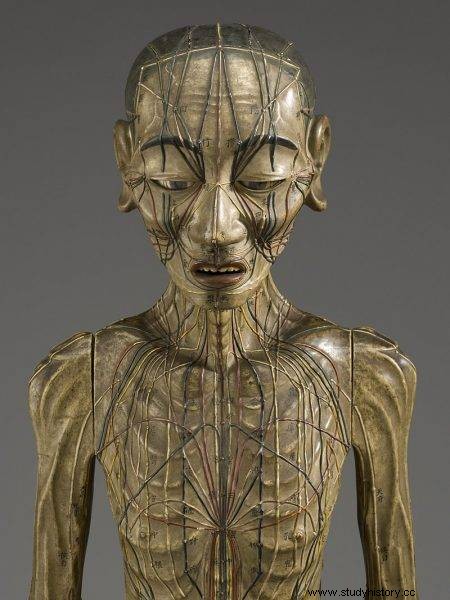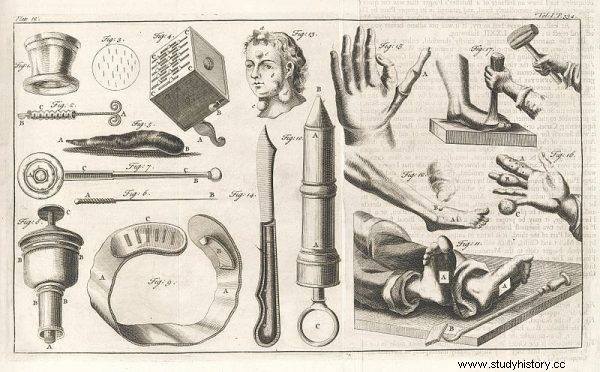Some people are afraid of needles. Others - stick them into the body to heal themselves. The inventor of acupuncture will likely remain anonymous. What do we know about its history?
The oldest thin healing needles were used several thousand years ago. Today, this technique is known almost all over the world. It allows, among others to… operate on conscious patients.
In search of the oldest needles
So far, no one has been able to determine where, when and how acupuncture was born. If we were to focus on the legends - its source is the experiences of soldiers who noticed the impact of arrow wounds on other places in the body, seemingly unconnected . Theories about the origins of reflexotherapy go even further. According to them primitive people instinctively found and massaged points responsible for pain reduction .
Let's move for a moment to the areas of the Mongolian Upland. Excavations in Toudaowa in 1963 brought an interesting discovery. Among the everyday objects dating back to the Neolithic era are stone needles. They were probably used for acupressure , that is, healing by applying pressure to the right places, without breaking the continuity of the skin. Other tools found throughout China were most often made of flints, quartz and jade, as well as bamboo and bones. However, it is difficult to determine whether their purpose was to puncture specific points or more broadly understood medical incisions. Metal needles began to be used around the 2nd century BC. These have certainly been used in acupuncture.

Graph of acupuncture points from the Ming Dynasty
Although the Chinese are believed to be the fathers of this art, the method was fairly widespread. Outside Asia, it was practiced in Egypt, for example. A papyrus showing a map of puncture points is stored in the London museum. It was probably built one and a half thousand years BC.
Medicine of Fire and Iron
Methods developed in China, called Zhen-Jiu , are mainly based on cauterization and pricking. One of the first surviving documents on this subject dates back to 221 B.C.E. Treatise on Guts or Nature and Life contains indications and contraindications to the use of acupuncture, a description of 9 types of needles and about 300 puncture points. The book - according to the authors - is a summary of a tradition that is nearly 2,000 years old.
At the same time, what we would call conventional medicine, in particular surgery, is developing. Hua Tuo, considered a pioneer in this field, is also ... a master of acupuncture. He uses this method, for example, on politician Cao Cao, suffering from chronic headaches. Family educated doctors pass on from generation to generation knowledge of anatomy, pulse control and anesthetics . The latter, as it is easy to guess, are largely strong drugs.
By the end of the 3rd century CE the first detailed maps of over 600 points important for acupuncture are created and this art is spreading more and more in Asian countries. More than seven centuries later, Wang-Wei-yi creates brown mannequins with needle holes. The first medical schools training specialists in the Zhen-Jiu method are opening soon. It becomes a fully-fledged, sanctioned art of healing.
What is Qi energy ?
When you think about acupuncture, it's hard to break away from Eastern philosophical currents. The practice is based on theories describing the flow of energy in the human body . According to the assumptions of Chinese traditional medicine, it circulates in channels called meridians that create a closed circuit . These, in turn, intersect at certain points that are particularly important for the functioning of the entire organism. Such a system enables "communication" between all organs.

Wooden model for learning acupuncture from the turn of the 16th and 17th centuries
Probably everyone has heard of Yin and Yang . What do both elements mean? The first force is the negative feminine element. The second - masculine, considered positive . Both energies are constantly clashing. As long as they are in balance, a person is healthy. However, when one is missing, the opposite fills in the gaps and begins to dominate. This condition contributes to the development of the disease. The purpose of acupuncture is to restore homeostasis. By piercing the appropriate points, the energy flow in the meridians is regulated. Reducing, and sometimes even completely turning off the pain sensation works in a similar way.
Eastern art in Europe
Europeans first hear about acupuncture in the 13th century, mainly thanks to merchants, missionaries and travelers visiting the Far East. However, books systematising knowledge in this area are not being written for a long time. The first works did not appear until the 17th century. A total of 6 titles have survived from this period including Specimen medicinae Sinicae Polish missionary - Michał Boym. As one of the pioneers, he primarily describes heart rate diagnosis.
In the next century, there are more researchers interested in acupuncture. Eighteen works that were created at that time are now known. But a real boom begins in the nineteenth century in France. Thanks to the doctors of the time, a total of 142 essays on the techniques of treatment with needles are published . The method is practiced in the hospital. st. Louis in Paris and will soon be used in other European centers.
Magic or medicine?
When Europe discovers Chinese medicine, the Chinese… are moving away from it in favor of European practices. And while acupuncture is never rejected, it has been somewhat aloof from medical trends since the 18th century. The situation changes only 200 years later. And it has nothing to do with the lofty ideas of cultivating tradition. The reason is much more pragmatic. Conflicts in 20th-century China and World War II caused the country to lack doctors. Acupuncture is making a comeback when it begins to help keep soldiers in good shape.

Among traditional Chinese treatments, acupuncture has been approved by the WHO as a medical treatment.
Today, centers that use this practice are found almost all over the world. Chinese institutions practice the so-called integrative medicine, combining traditional and modern techniques. Is it right? On the one hand, vitalism, a concept based on the flow of energy in the body, is rejected by most doctors. On the other hand, acupuncture has been approved by WHO as a medical procedure.
Professor Kathy Sykes, working for Bristol University in Great Britain, tested the effectiveness of this method in Shanghai. She was there, among others witnessed open-heart surgery without general anesthesia. Instead - needles and less burdensome conventional anesthetics. Further research showed that acupuncture actually changes brain activity. Especially those areas that are responsible for feeling pain. And although it should not be an independent method of treatment, it is a good complement to therapy. Especially in the case of pain.
